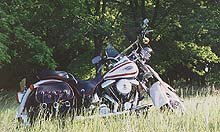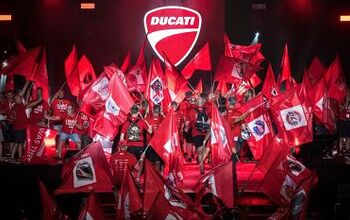Church of MO: 1997 Harley-Davidson Heritage Springer Softail
Twenty-five years ago, every Harley-Davidson review was laced with phrases like “for respectable older folks” and “aimed squarely at Harley’s newest riders: wealthy men over forty”… also, “not a bike for most women or smaller men.” Maybe all that was accurate in 1997, but now that we’re all respectable old gender-neutral weaklings, it’s quaint to look back and wonder how we ever got along with a tiny 1340 cc H-D? Egads man… and when will H-D bring back the Springer front end?
Harley Reaches Back Even Farther
A bike of details
In re-creating the past, the Motor Company has seen to every detail but have also donned a pair of thick rose-colored glasses. In this rare case, the original can’t compare with the copy. In fact, when you really examine old Panheads, you are surprised by how delicate they look by comparison.
They were certainly reliable bikes for their time, but were born in an era where cost was an issue and image wasn’t everything. By contrast, everything on the FLSTS is heavy-duty, designed for beauty and chromed to within an inch of its life. Gone are the exposed wires, the untreated metal pieces and, of course, that spring-loaded saddle floating 10 inches above the frame.
The ’97 Heritage Springer is an impressive looking machine. A bike of details. It benefits from the fact that it was designed in an era where cost is basically not an issue for bikes bearing the H-D logo. The original Pans didn’t have that luxury.
For instance, after designing two of the best looking fenders ever, the good folks in Harley’s design department slapped on a trick looking tombstone taillight and front running light, making those fenders just that much more impressive.
Another such detail is the horn. Prominently displayed right up front, atop the damper, this thing is a brilliant reproduction of the original. And it works great, too. Nice and loud and pointing straight ahead instead of down into your left boot.
What’s the big deal about a bike that essentially looks like a Heritage Softail with new fenders and a springer front end grafted on? Well the springer forks that have been around since 1988 are designed for a skinny 21 inch tire.
This nostalgic bike demanded a fat 16 inch tire. Creating this proved a little more tricky than simply widening the existing springer setup.
The added weight of the 16 inch tire required changing its geometry (i.e. rake & trail). H-D’s engineers were equal to the task though, and have designed a new front end that is rock solid at modern highway speeds. Even in Montana.
Heavy Metal
The view from the saddle is fabulous. Nothing but chrome as far as the eye can see. Starting with the chrome dashboard, you move up to two stout chrome risers, and then onto the funny looking top springs. And finally the coup de grâce: Three beautiful chrome orbs that are the backsides of the head lamps. This could be the coolest view in all of motorcycling.
One unfortunate side effect to re-creating every detail of an old bike is that your curb weight numbers go through the roof. This bike weighs a ton – 690 pounds to be precise. And it doesn’t hide a single ounce of it. By comparison the standard Springer weighs in at 625 pounds. Curiously a Heritage Softail, weighing 14 pounds more, conceals its mass much better.
The Heritage Springer’s fancy new front end is damn heavy, feeling like all the weight of the bike is resting on that front wheel. Simple parking lot maneuvers are minor tests of strength. Stopping and starting two-up in the city are not to be taken lightly either.
You have to stay alert and establish solid footing with each and every stop. This is not a bike for most women or smaller men. Neither the standard Springer nor the Heritage Softail share this super-heavy feel.
Another unfortunate retro side-effect might be found in the transmission. We like Harley’s new gear ratios more with every Softail we ride. 70 mph is now a comfortable reality. Having said that, we haven’t heard a Harley tranny this loud in years. All late model Harleys we’ve ridden offer up a quiet yet solid “click,” when changing gears. This scooter lets out a loud “clunk,” just like the old ones. This is not a retro-feature we want back. An anomaly? Probably. But for $16,995 there should not be any such anomalies.
On a more positive note, the new two-into-two exhaust was quite a treat. A unique sounding Harley to be sure. Resounding throaty and noticeably different from the usual staggered duals exhaust note. More like an old BMW than a V-twin. We’d really love to hear this bike with its baffles popped out.
The new exhaust system would also be a great addition to a Heritage Softail. It looks great, comes complete with fishtail-like tips and benefits from a lack of the universally-hated crossover pipe. A great new system.
Accessories
What would a new Harley model be without new accessories? We don’t know.
And not wanting to find out themselves, the Motor Company has a whole new line dedicated to the Heritage Springer. Everything from fringed mud flaps to fringed jackets are available to the FLSTS owner.
We opted for a smoked, “sport” windshield. It is an excellent addition to the bike, both in terms of comfort and style. It’s also a pleasure to see an add-on item so well designed. The shield fit like it came on the bike as original equipment. No detail was forgotten.
Best of all, Harley-Davidson employs at least one real-live technical writer! If there is one place that nearly all aftermarket companies fall flat, it is in writing installation instructions. The instructions included with the Heritage windshield were just the opposite.
A logical progression of how to take the old parts off, install the new parts and where to use blue Loctite. Kudos to the technical writing staff at H-D.
“Although we doubt anyone thought it possible, Harley-Davidson has once again pushed the retro-bike bar up a notch.”
Anyone trying to sell a “classic American cruiser” now has a new yard stick by which to be measured. With its latest bike, the 94-year-old company has truly come full circle. It took Harley just over 20 years to come out with their first “factory chopper,” the 1971 Super Glide.
But it took nearly 50 years to re-create a bike that precipitated the chopper craze. And strangely enough, what amounts to the “chopped” version of the Heritage Springer bowed back in 1995 under the Bad Boy moniker.
The FLSTS Heritage Springer Softail is a beautiful ride aimed squarely at Harley’s newest riders: wealthy men over forty. Its beauty is obvious and can be found in a thousand details. However, 99 percent of the motorcycling population will roll their eyes when they see this one coming.
Big and voluptuous — but also slow and heavy — this bike is truly a love or hate proposition. Most will find it at best amusing, but the few who understand its appeal will love it for life.
Specifications:
Manufacturer: Harley-Davidson Model: 1997 FLSTS Price: $16,995 Engine: V-twin OHV Evolution Bore and Stroke: 3.498 x 4.250 in. Displacement: 1340cc Carburetion: 40mm Constant Velocity Transmission: 5-speed constant mesh Wheelbase: 63.07 in. Seat Height: 25.75 in. Fuel Capacity: 4.2 gal. incl .4 reserve Claimed Dry Weight: 690 lbs.
More by John Burns



































Comments
Join the conversation
I remember folks on the Motorcycle.com forum calling those riders GPTB. :)
Bought my 98 FLSTC with 5 miles on the clock in 1998, now has over150,000 and been to every state at least once...replaced a shovelhead with it.